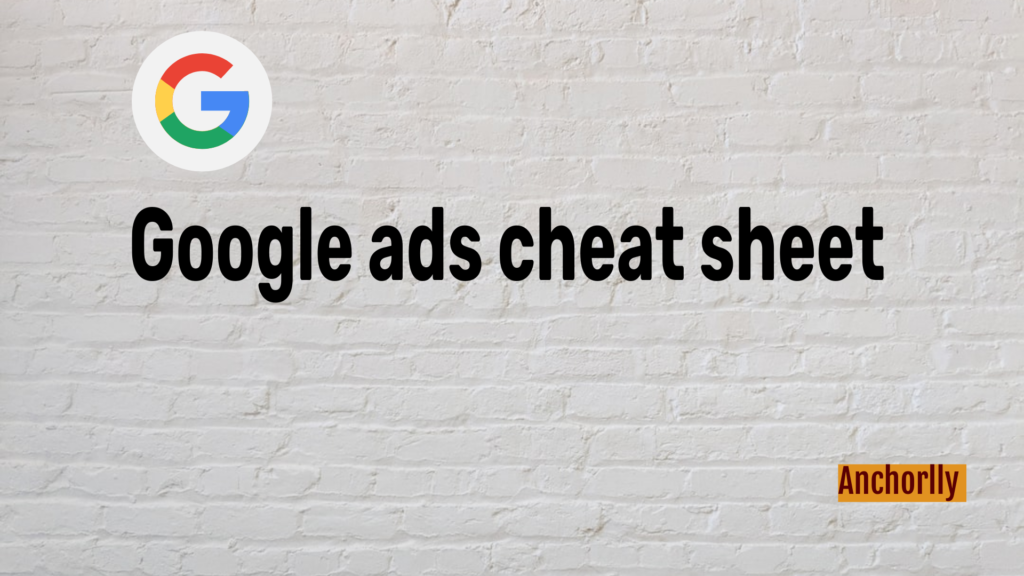Navigating the complexities of Google Ads can be difficult, but with the appropriate methods, you can increase your ROI and meet your marketing objectives. This Google Ads cheat sheet includes critical ideas, strategies, and best practices for creating and managing effective campaigns. Whether you’re a newbie or an experienced marketer, this guide will help you streamline your strategy and ensure that your advertising functions optimally.
Table of Contents
ToggleGoogle Ads Cheat Sheet: Dynamic Tools to Increase Efficiency of Campaigns & Increase ROI Resultantly.
Using Google Ads feels overwhelming, but with proper strategies, you stand to have a high ROI, drive quality traffic, and reach your marketing objectives. Whether you’re a beginner to paid advertising or you want to improve your approach, this SEO-optimized Google Ads cheat sheet contains valuable tips, techniques, and best practices to run effective campaigns.
Click here for more amazing information.
1. Google Ads Cheat Basics: Start With the Right Foundation
Select the Adventurous Campaign Type Google Ads presents various campaign types, some of which are:
- Search Ads for capturing intent-based traffic.
- Display Ads for brand visibility
- Shopping Ads for eCommerce promotions
- YouTube video Ads (engaging content)
- Mobile app promotion using App Campaigns
Understand Ad Rank and Quality Score What affects your Ad Rank is
- Your bid
- Quality Score (CTR, relevancy of ads and landing page experience)
- Ad extensions and expected performance
Master Bidding Tactics Choose the correct bidding tactics according to your goals:
- Manual CPC for granular control
- Enhanced CPC (ECPC) for semi-automation
- Target CPA for conversion-driven campaigns
- Target ROAS for revenue-focused goals
2. Keyword Research and Match Types
Utilize the Google Keyword Planner tool Identify high-intent, low-competition keywords that fit in with your business objectives.
You should search for long-tail keywords to obtain qualified traffic.
Leverage:
Keyword Match Types
Broad Match:
Reach a wide audience
Phrase Match:
Display ads against more precise search words.
Exact Match:
Target high-converting queries
Negative Keywords:
Eliminate useless traffic and cut a budget.
Tip: Regularly update your Search Terms Report to help define keyword targeting.
3. Writing High-Converting Google Ads Copy
For Google Ads Cheat Sheet Design, Enthralling Ad Copy, your ad should possess:
- A focus keyword
- Clear call-to-action (CTA)
- Unique selling propositions (USPs)
- Emotional or urgency triggers
Ad extensions will boost visibility:
Use them, such as
- Sitelinks
- Callouts
- Structured snippets
- Call extensions
These expand your ad space and also your click-through rate (CTR).
4. Improve your landing pages for best conversions.
Ad-Landing Page Relevance Keep a high correlation between your ad copy and the landing content to increase the Quality Score and decrease the bounce rate.
- Improve User Experience (UX)
- Fast page load speed
- Mobile responsiveness
- Clear navigation
- Strong CTA above the fold
- Test the variations of Run A/B Tests
- Headlines
- Images
- Button placements
- Form lengths
Use insights to see how conversion rate gets better with time.
5. Smart Budgeting and Scheduling for Google Ads Cheat Sheet
Set Daily Budgets Purposefully Make the campaign spend agree with your business goals. It is advisable to use Manual CPC or Target CPA to control costs effectively.
Advertising
Ad Scheduling Run your ads at the times your target audience is active. Modify bid modifiers according to time and day.
Geotargeting
Use your ads to target high-performing locations to avoid waste of money and better local targeting.
6. Monitoring, Reporting & Optimization for Google Ads Cheat Sheet
Track Key Performance Metrics On a regular basis, review:
- CTR
- Conversion Rate
- Cost per Acquisition (CPA)
- Impression Share
- Quality Score
Use Search Terms Report Discover new keyword potential and eliminate useless queries to populate your negative keyword sheet.
Ad Rotation Test allows enabling the test of multiple ad versions and allowing Google to optimize for the highest performance automatically.
7. Implement Effective Remarketing for Google Ads Cheat Sheet
Create Remarketing Audiences
Connect with visitors who came to your site but weren’t converted. Segment audiences based on behavior.
Dynamic Remarketing
Use it to display customized ads of products or services that users viewed at your site.
Use Frequency
Capping to avoid overexposure and decrease ad fatigue by capping the number of times users are shown your ads.
8. Utilize Advanced Google Ads Features
Audience Targeting Tools Create a refined targeting using:
- Affinity Audiences
- In-Market Audiences
- Custom Intent Segments
Track Accurately
Conversion tracking to track actions such as purchases, sign-ups, and downloads.
Combine Google
Analytics Link Google Ads to Google Analytics for deeper insights on:
- User behavior
- Traffic sources
- Conversion paths
This integration is critical in making data-driven decisions.
Final Thoughts for Google Ads Cheat Sheet:
Sweep Google Ads using Strategy and Precision
By implementing these proven Google Ads strategies, you’ll improve your campaign performance, lower ad spend waste, and increase your return on investment. Keep updated with the latest developments on Google Ads, conduct regular auditing of your campaigns, and improve tactics in an ever-changing digital marketing environment.

